Vishwakarma Jayanti
Organised by Ritambhara
in collaboration with
Dr. V. Ganapati Sthapati Research Foundation
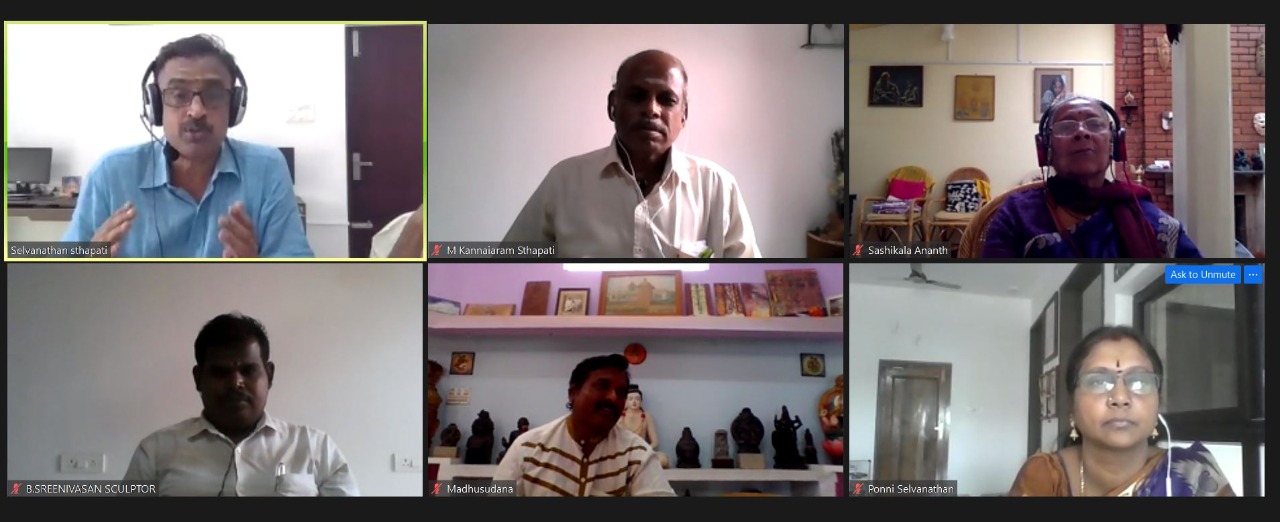
On Sep 17th 2020, we celebrated ‘Vishwakarma Jayanti’ in the honour of Lord Vishwakarma and the traditional craftsmen, sculptors and architects across the generations, as an online event with participants who joined us from various parts of the world. As part of the celebration, the work of four Sthapatis and Shilpis from Tamil Nadu and Karnataka was acknowledged and felicitated.
The program began with an invocation by Gayathri Shanmugavelan to Swayambu Vishwakarma who is considered to have created everything in the world when nothing else existed.
Following this, Architect Sashikala Ananth shared an inspiring message on her journey with vAstu, the Parampara Siksha of the Vishwakarma tradition and work being done at Ritambhara to bridge Indian traditional knowledge with contemporary lifestyles. The following paragraphs are excerpts from her speech-
For thousands of years, India has boasted of some of the most beautiful, durable and unique, aesthetic art work that stands as a sentinel of our past glory. This great art has not been celebrated sufficiently in the last few decades. Both the art and the practitioner have survived the ravages of time and continue to practice their marvelous craft with the same dedication and superb quality to this day.
The most important aspect of our traditional craft and the skill of our artisan is that it was part of mainstream life and interlinked with the built environment. Therefore, the beautiful carvings in wood work and stone work, the exquisitely made furniture, the aesthetically pleasing metal cookware, the incomparable woven fabric for the interiors were all part of the built environment till a hundred years ago. But today the craft skill has become exclusive and a rarity and a market for the wealthy. The Vishwakarma who were part of everyday life have been sidelined into the marginalised people in our society. It is time that we recover this extraordinary heritage and make it a part of our life. Just as we ought to embrace handicrafts as a part of our life, designers, architects and house owners can commit to include the artisan and the crafts people in their built process.
The vAstu shilpa shAstra are an extremely potent as well as viable resource for us to bring into our design methodology. I have studied these texts under the able guidance of Shri Ganapati Sthapati for over 10 years. My attempt has been to make this textual knowledge available to students from India and other parts of the world. The theoretical study as well as field application is being taught regularly through Ritambhara. Secondly, we are also attempting to create a platform to bring the skills and capability of the Vishwakarma to various applications. In this endeavor we have started collecting data about the Vishwakarma and their skills to make it available as a directory for application in the built environment.
We hope to be able to celebrate this ‘Vishwakarma Jayanti’ every year and bring to the limelight craftspeople and artisans from various parts of the country.
A beautiful presentation by Ponni Selvanathan on Temple Restoration – Jirnoddhara, set the stage for another insightful presentation by Gayathri Shanmugavelan on the Vishwakarma tradition and the work done by the artisans.
T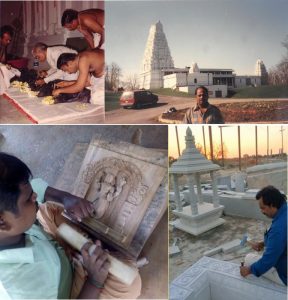 he highlight of the event was the pre-recorded interviews of Sri R. Selvanathan Sthapati (from Chennai), M. Kannairam Sthapati (from Kanchipuram), B. Srinivasan Shilpi (Mahabalipuram) and H. Madhusudhana (Bangalore), where they reflected on their journeys and experiences as traditional artists and offered amazing insights into their craft and training.
he highlight of the event was the pre-recorded interviews of Sri R. Selvanathan Sthapati (from Chennai), M. Kannairam Sthapati (from Kanchipuram), B. Srinivasan Shilpi (Mahabalipuram) and H. Madhusudhana (Bangalore), where they reflected on their journeys and experiences as traditional artists and offered amazing insights into their craft and training.
Finally, a panel discussion took the event to a new space where people got an opportunity to interact directly with the unsung heroes of this artform. Sri D.V. Sridharan, senior member of the Indic Academy then felicitated the Vishwakarma shilpis towards the end of the momentous celebrations and shared his message on the important role of the Vishwakarmas in representing and carrying forward the Dharma. Following is an excerpt from his speech-
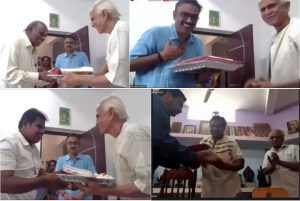
Our Dharma is written in the books. Not everyone can read them since it is in Sanskrit but everyone can respond and be invoked by seeing a temple structure or a sculpture. I believe the Vishwakarmas have visually rendered our dharma and I am grateful to be in the presence of such Masters. I think there are two things our civilization depends on – traditional agriculture that venerates the soil and the work of the Vishwakarmas. The more the people get involved with natural agriculture and sit at the Vishwakarma to learn their art, they will be doing a huge service in taking our civilisation and Dharma forward.
The celebrations ended with a vote of thanks by Sashikala Ananth, acknowledging the efforts put in by the Vishwakarmas, the co-hosts from Dr. V. Ganapati Sthapati Research Foundation and the Ritambhara vAstu Sangha for making this event possible.
The event received inspiring responses from people who work closely with different areas of Indian heritage- especially the arts and architecture, a few of them read as follows.
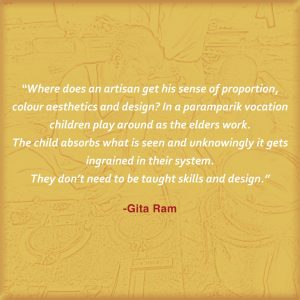
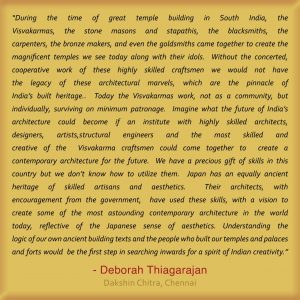
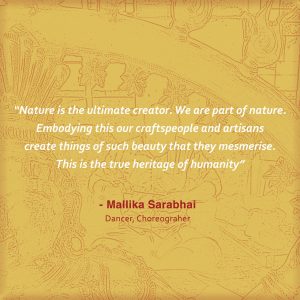
You may watch the Vishwakarma interviews here.
If you missed the live event, please watch the recording of the Vishwakarma Jayanti event here.


 Priya is a Yoga therapist in the Krishnamacharya tradition. She adapts Reiki & energy work, Vedic chanting, life coaching & Ayurvedic practices in her healing spaces. She is committed to nurturing collectives that have the praxis of Yoga at their heart.
Priya is a Yoga therapist in the Krishnamacharya tradition. She adapts Reiki & energy work, Vedic chanting, life coaching & Ayurvedic practices in her healing spaces. She is committed to nurturing collectives that have the praxis of Yoga at their heart. Anisha has been on an exploration to understand herself through yoga for the last 15years which led her to teaching yoga, yoga therapy and inner work through yoga.
Anisha has been on an exploration to understand herself through yoga for the last 15years which led her to teaching yoga, yoga therapy and inner work through yoga. Apoorva chanced upon Yoga in her early 20s. A spark was lit within and there was no turning back. Her exploration led her to the Krishnamacharya tradition more than a decade ago. Curious about human behaviour and what drives it, she was thrilled when her search ended (and also began) when she first came upon the Yoga Sutra, which illuminated a path towards answering many questions that had been held for a long time.
Apoorva chanced upon Yoga in her early 20s. A spark was lit within and there was no turning back. Her exploration led her to the Krishnamacharya tradition more than a decade ago. Curious about human behaviour and what drives it, she was thrilled when her search ended (and also began) when she first came upon the Yoga Sutra, which illuminated a path towards answering many questions that had been held for a long time. Anita is a yoga teacher and therapist in the tradition of Sri.T.Krishnamacarya and Sri T.K.V. Desikachar, a Reiki practitioner and a Life Coach. She is also the founder of Vishoka, a center for learning Indic and energy-based frameworks for living and healing. Her deep concern for human suffering and the problems of unsustainable living kept her on the path of seeking an integrated approach to looking at life, living, learning and healing.
Anita is a yoga teacher and therapist in the tradition of Sri.T.Krishnamacarya and Sri T.K.V. Desikachar, a Reiki practitioner and a Life Coach. She is also the founder of Vishoka, a center for learning Indic and energy-based frameworks for living and healing. Her deep concern for human suffering and the problems of unsustainable living kept her on the path of seeking an integrated approach to looking at life, living, learning and healing. Ankit is a seeker in the wisdom traditions of India. The core of his work includes creating dialogic spaces where people can look within and see the connection between their inner and outer lives. Inspired by the likes of Gandhi, Aurobindo, Vivekananda and Guru Gobind his experiments in service took him back to his roots in Punjab where he is creating a community-led model of higher education which is open, inclusive and accessible for all. Ritambhara for him is a space for engaging in a community which is committed to a DHramic life. He anchors his work of learning and leadership in the Antaranga Yoga Sadhana and the humanistic wisdom of Mahabharata.
Ankit is a seeker in the wisdom traditions of India. The core of his work includes creating dialogic spaces where people can look within and see the connection between their inner and outer lives. Inspired by the likes of Gandhi, Aurobindo, Vivekananda and Guru Gobind his experiments in service took him back to his roots in Punjab where he is creating a community-led model of higher education which is open, inclusive and accessible for all. Ritambhara for him is a space for engaging in a community which is committed to a DHramic life. He anchors his work of learning and leadership in the Antaranga Yoga Sadhana and the humanistic wisdom of Mahabharata.